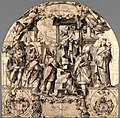File:Ecce Homo, the king Caspar, the Virgin and Child and the Arms of the Families Kündig and Pfyffer.jpg
From Wikimedia Commons, the free media repository
Jump to navigation
Jump to search

Size of this preview: 604 × 599 pixels. Other resolutions: 242 × 240 pixels | 484 × 480 pixels | 998 × 990 pixels.
Original file (998 × 990 pixels, file size: 874 KB, MIME type: image/jpeg)
File information
Structured data
Captions
Captions
Add a one-line explanation of what this file represents
Summary[edit]
| DescriptionEcce Homo, the king Caspar, the Virgin and Child and the Arms of the Families Kündig and Pfyffer.jpg | Ecce Homo, the king Caspar, the Virgin and Child and the Arms of the Families Kündig and Pfyffer, J. Paul Getty Museum. Note: This drawing, a design made for a stained glass window at a Swiss abbey, depicts the Ecce Homo. Crowned with thorns, Christ is displayed before the jeering crowd by Pontius Pilate shortly before he is crucified. Christ, scourged and bound, looks out at the masses while Pilate gazes out at the viewer, as if to implicate him or her in the action. Framing the scene are the Virgin and Child, the wise man King Caspar, and angels who bear instruments of the Passion. Below are the arms of the families from Lucerne who commissioned the window: the Kündigs, documented as bailiffs, and the Pfyffers, who were of noble stock. Murer's drawing is part of a large and important series of stained glass window designs for the cloister of the Cistercian abbey of Rathausen in the canton of Lucerne. The works were executed between 1592 and 1623 and comprised sixty seven panes depicting scenes from the Old and New Testaments. Until 1611, the windows were made by Franz Fallenter, who followed the designs of various Swiss artists, including Daniel Lindtmayer, Hans Heinrich Wagman, and Christoph Murer. The large size and shape of the drawing, made from four sheets of paper glued together, match the actual dimensions of the window, which is preserved in Schloss Heidegg, Switzerland. The window is signed and dated by Fallenter (FF 1593). | |||||||||||||||||||||||||
| Date | ||||||||||||||||||||||||||
| Source | https://www.getty.edu/art/collection/objects/327733/christoph-murer-ecce-homo-the-king-caspar-the-virgin-and-child-and-the-arms-of-the-families-kundig-and-pfyffer-swiss-1592/?dz=0.5000,0.5000,0.60 | |||||||||||||||||||||||||
| Author |
creator QS:P170,Q1085550 |
|||||||||||||||||||||||||
| Permission (Reusing this file) |
|
|||||||||||||||||||||||||
File history
Click on a date/time to view the file as it appeared at that time.
| Date/Time | Thumbnail | Dimensions | User | Comment | |
|---|---|---|---|---|---|
| current | 03:02, 19 March 2022 |  | 998 × 990 (874 KB) | Taterian (talk | contribs) | removed opaque background |
| 02:56, 19 March 2022 |  | 1,024 × 1,011 (810 KB) | Taterian (talk | contribs) | {{Information |Description=Ecce Homo, the king Caspar, the Virgin and Child and the Arms of the Families Kündig and Pfyffer, J. Paul Getty Museum. Note: This drawing, a design made for a stained glass window at a Swiss abbey, depicts the Ecce Homo. Crowned with thorns, Christ is displayed before the jeering crowd by Pontius Pilate shortly before he is crucified. Christ, scourged and bound, looks out at the masses while Pilate gazes out at the viewer, as if to implicate him or her in the actio... |
You cannot overwrite this file.
File usage on Commons
There are no pages that use this file.